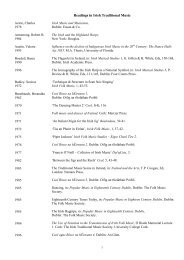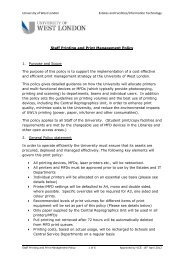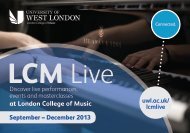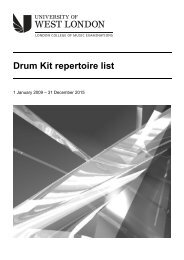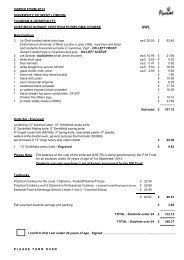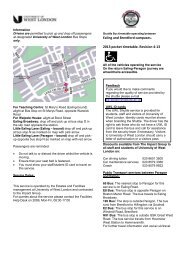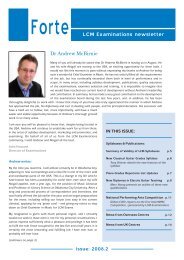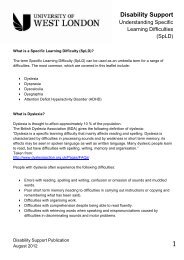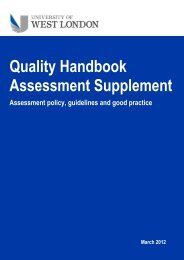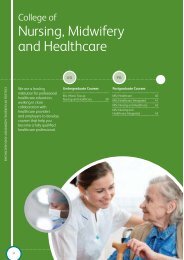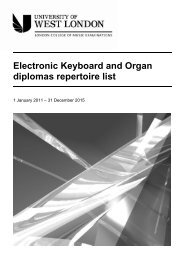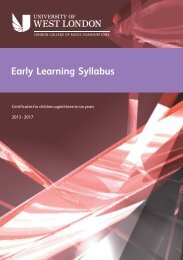LCM Exams - Church Music Diplomas - University of West London
LCM Exams - Church Music Diplomas - University of West London
LCM Exams - Church Music Diplomas - University of West London
- No tags were found...
Create successful ePaper yourself
Turn your PDF publications into a flip-book with our unique Google optimized e-Paper software.
Component 3: Viva VoceThe examiner(s) will lead the candidate in a discussion about the music performed in Components 1 and 2. Thecandidate will be expected to demonstrate detailed technical and contextual knowledge about the repertoire.Questions may be asked on the following:• explanation <strong>of</strong> musical symbols and terms as found in the scores;• formal, structural, tonal, harmonic, melodic and rhythmic structures;• background knowledge <strong>of</strong> the composer and the historical context;• the candidate's personal response and approach to learning and performing the music;• how each item presented in Component 1 might be used in the context <strong>of</strong> a service or act <strong>of</strong> worship;• some <strong>of</strong> the practical issues surrounding church music, including:- recruitment <strong>of</strong> musicians;- rehearsing and training;- selection, availability and appropriateness <strong>of</strong> repertoire.A more detailed understanding will be expected than for Dip<strong>LCM</strong>.Component 4: Sight Reading (or alternative test as appropriate)A test for the candidate’s principal instrument will be given. Candidates <strong>of</strong>fering voice as their principal instrumentmay select the requirements for either Classical Singing or Popular <strong>Music</strong> Vocals.4a. Pipe Organ: Keyboard Tests• Sight Reading (manuals and pedals): three staves;• Score Reading (to be played on manuals only): four parts, SATB, the tenor part to be written in treble clef; SAand/or TB parts may cross;• Transposition (to be played on manuals and pedals): a chorale-style hymn tune, up or down a tone orsemitone.Specimen tests are available (LL11673).4b. Electronic Organ & Keyboard: Chord Sequence OR Accompanying TestCandidate to select ONE from the following (before the tests are seen):1. Chord sequence test: A written chord sequence <strong>of</strong> 8 bars will be provided, using chord symbols. The candidatemay play through the sequence once. They will then be asked to play it adding an improvised melody line. Theperformance may be given with or without the use <strong>of</strong> a rhythm unit.2. Accompanying test: An 8 bar piece will be provided written for right hand treble clef, left hand bass clef, withchord symbols. A melody will also be written for the examiner to play. The candidate may look at the piece, thenlisten to the examiner play the melody at a designated tempo. The candidate will then accompany the examineras he/she plays the melody once more. The accompaniment may consist <strong>of</strong> left hand chords only, or may pick upsome detail from bass clef reading, or may also include a right hand counter-melody. Higher marks will beawarded for a more effective accompaniment. The test will take place without the use <strong>of</strong> the rhythm unit.Specimen tests are available (LL117).4c. Piano, Classical Guitar & Classical Singing: Sight ReadingCandidates will be given approximately one minute's preparation time to study a short piece <strong>of</strong> previously unseenmusic. During this time, they may 'try out' small sections <strong>of</strong> the music, but they may not play the whole piece throughfrom beginning to end. Following the preparation time, the examiner will ask the candidate to perform the music.Specimen tests are available (Piano LL10653; Classical Singing LL10779).4d. Popular <strong>Music</strong> Vocals: Sight Singing OR Improvisation TestCandidates may choose whether to take the Sight Singing test or the Improvisation test.1. Sight Singing: The candidate will be shown a melody <strong>of</strong> approx. 12-16 bars in length, with chord symbols abovethe stave. The examiner will give the key and the starting note, following which the candidate will be allowedapproximately 1 minute to study and practise the melody. The examiner will then give the key and starting noteone more time, followed by a count-in, and the candidate should then sing the melody to an appropriate sound<strong>of</strong> their own choice such as ‘ah’, ‘ooh’ or ‘la’. The examiner will provide accompaniment, in the form <strong>of</strong> block18




